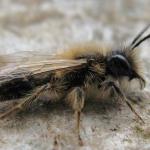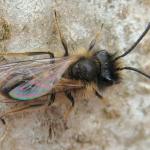This species is one of the first bees to appear in the spring, with individuals regularly found in early March in southern England. Andrena praecox (Scopoli) frequently flies with this species. As with most of these early species, foraging flights are made almost exclusively to sallow catkins.
Local in southern Britain, the range extending northwards to Cumberland. There is an old record from Herm, Channel Islands (Luff, 1905). In Ireland, known from Wexford, Kilkenny, Wicklow and Dublin (Stelfox, 1927). Widely distributed in the Palaearctic, occurring from Fennoscandia south to Spain and east to Kamchatka and Japan.
A Notable B species (Falk, 1991) [now known as Scarce (Nb)].
Open deciduous woodland and abandoned sand and chalk quarries.
Univoltine; early March to late April, rarely May.
The nest burrows are generally excavated in level soil. Nests occur either singly or in small, open aggregations, the burrow entrances being rather widely scattered (pers. obs). Large compact aggregations, however, have been recorded (Perkins, 1919). Males are either seen flying low and fast over open ground, or zigzagging up tree trunks and telegraph posts, presumably in their search for receptive females. Both sexes occasionally alight on such surfaces.
Gorse, sallow and plum. On mainland Europe, the species has been noted visiting alder (Alnus glutinosa), colt's-foot (Tussilago farfara) and dandelion (Taraxacum officinale) flowers (Dylewska, 1987). Males rarely seem to visit flowers, though specimens are commonly dusted with pollen grains, suggesting they do so.
The bee Nomada leucophthalma (Kirby) is a well known cleptoparasite of this species (Perkins, 1919; Westrich, 1989). Stylopized individuals of the Andrena have been reported from Sussex (Perkins, 1919).
2002



